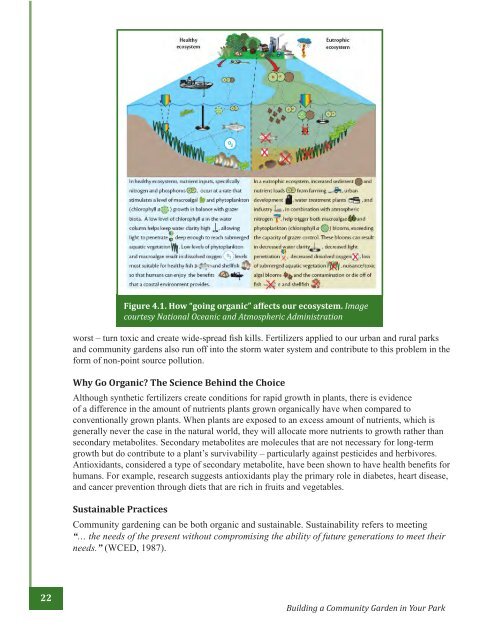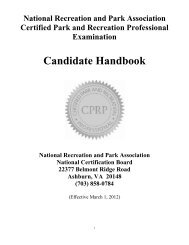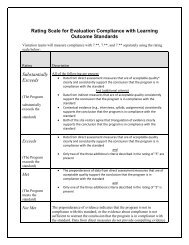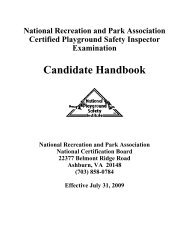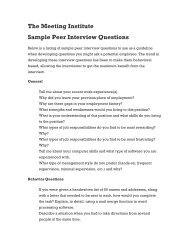CHAPTER 4: ORGANIC AND SUSTA<strong>IN</strong>ABLEBefore moving to the next stages of your community garden project, it is important to thinkabout two other considerations: organic and sustainable. As park and recreation professionals,and as natural resource managers, we have the opportunity to highlight our projects andprograms in terms of their many benefits to people as well as the environment. A community gardenprovides a wonderful context for both. This section addresses some of those benefits relative toorganics and sustainability.What is “Organic”?Before we discuss how to create an organic garden, we first need to identify what the word “organic”actually means. Organic can have different meanings for different individuals. Organic gardeninggenerally refers to the practice of growing foods without synthetic fertilizers or chemicalpesticides. Organic agriculture, according to the United States Department of Agriculture (2010), is“…a production system that is managed to respond to site-specific conditions by integrating cultural,biological, and mechanical practices that foster cycling of resources, promote ecological balance,and conserve biodiversity.”Generally, conventional agriculture involves growing crops in a monoculture (e.g., for a singlegrowing season, a farmer would only grow a single variety of crop). This monoculture is grown usingsynthetic fertilizers and chemical pesticides to maximize growth and minimize any possible cropreduction. Organic agriculture can incorporate various growing methods and involves, oftentimes,growing multiple crops in the same field.What are Synthetic Fertilizers?Nitrogen, potassium, and phosphorous are the three macro nutrients essential to plant growth. Innature, nitrogen is a very limited nutrient. While essential to plant growth, plants cannot use theorganic form of nitrogen, which is abundant in the atmosphere. Instead, microbes in the soil must“fix” nitrogen to make it available to plants to use. In this symbiotic relationship, microbes withinthe soil create ammonia from the organic form of nitrogen, which makes its way into the soil throughdecaying plant and animal matter. The ammonia can then be used by plants to build essential aminoacids and DNA for reproduction.Synthetic fertilizers also contain the three essential macro nutrients, but the significant differencebetween synthetic and organic fertilization is that the nitrogen in synthetic fertilizers (as opposed toorganic compost) is in a ready-to-use form; therefore, plants do not need the microbes in the soil toprocess the nitrogen and make it usable. When synthetic fertilizers are applied to a crop field, theyare often applied in excess. The plants use these macro nutrients for rapid growth, and any remainingnutrients are leached from the soil through rain water runoff. These nutrients make their way intolocal watersheds and can create serious problems, such as toxic algal blooms and dangerously lowlevels of dissolved oxygen (Figure 4.1).Nitrogen, phosphorous, and potassium nutrients tend to be limited in the natural world. Whenthese three nutrients leach into local watersheds, the microscopic phytoplankton readily use themfor very rapid growth. This growth can quickly turn into large-scale algal blooms (those undesirablegreen, goopy layers of vegetation floating on the top of your park’s water bodies). These algal bloomscan then block sunlight to submerged vegetation, create low levels of dissolved oxygen, and – at their<strong>National</strong> Recreation and Park Association21
Figure 4.1. How “going organic” affects our ecosystem. Imagecourtesy <strong>National</strong> Oceanic and Atmospheric Administrationworst – turn toxic and create wide-spread fish kills. Fertilizers applied to our urban and rural parksand community gardens also run off into the storm water system and contribute to this problem in theform of non-point source pollution.Why Go Organic? The Science Behind the ChoiceAlthough synthetic fertilizers create conditions for rapid growth in plants, there is evidenceof a difference in the amount of nutrients plants grown organically have when compared toconventionally grown plants. When plants are exposed to an excess amount of nutrients, which isgenerally never the case in the natural world, they will allocate more nutrients to growth rather thansecondary metabolites. Secondary metabolites are molecules that are not necessary for long-termgrowth but do contribute to a plant’s survivability – particularly against pesticides and herbivores.Antioxidants, considered a type of secondary metabolite, have been shown to have health benefits forhumans. For example, research suggests antioxidants play the primary role in diabetes, heart disease,and cancer prevention through diets that are rich in fruits and vegetables.Sustainable PracticesCommunity gardening can be both organic and sustainable. Sustainability refers to meeting“… the needs of the present without compromising the ability of future generations to meet theirneeds.” (WCED, 1987).22Building a Community Garden in Your Park


